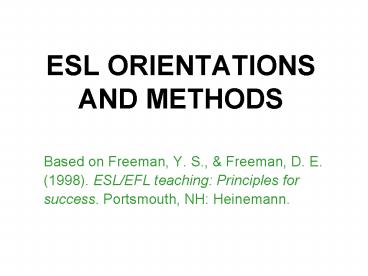ESL ORIENTATIONS AND METHODS - PowerPoint PPT Presentation
1 / 9
Title:
ESL ORIENTATIONS AND METHODS
Description:
English Language Teaching Orientations. Grammar-Based Orientation. Communicative Orientation ... Lessons should support students' first languages and cultures. ... – PowerPoint PPT presentation
Number of Views:807
Avg rating:3.0/5.0
Title: ESL ORIENTATIONS AND METHODS
1
ESL ORIENTATIONS AND METHODS
- Based on Freeman, Y. S., Freeman, D. E. (1998).
ESL/EFL teaching Principles for success.
Portsmouth, NH Heinemann.
2
English Language Teaching Orientations
- Grammar-Based Orientation
- Communicative Orientation
- Empiricist Orientation
- Rationalist Orientation
- Sociopsycholinguistic Orientation
3
Grammar-Based Orientation
- Grammar Translation Method
- Study grammar and vocabulary
- Develop ability to translate between English and
the students primary language
4
Communicative Orientation
- Direct Method
- Associations between objects/concepts and the
corresponding English words - Lessons organized around topics (body parts,
food, clothing) - Primary focus on spoken language
5
Empiricist Orientation
- Audiolingual Method
- Dialogues that include a particular structural
pattern - Exercises based on the dialogue
- Emphasis on development of oral language
- Notional-Functional Approach
- How languages express specific notions (time,
space) and specific functions (greetings,
apologies) - Widely used in ESL/EFL settings with adult
learners - Suggestopedia
- Eliminate psychological barriers to language
learning - Comfortable setting, music, yoga breathing
- Teacher decides on material to present
6
Rationalist Orientation
- The Silent Way
- Teacher is silent most of the time (models an
expression only once), color-coded rods - Students work together to develop own internal
understanding of the language - Community Language Learning
- Teachers serve as counselors to facilitate
learning - Teacher/students form a learning community to
lower defenses and encourage open communication - Curriculum comes from students
- Teacher translates into English what student
wants to say
7
Rationalist Orientation (continued)
- Total Physical Response
- Involves muscles as well as the mind
- Students respond to commands that become
progressively more complex - The Natural Approach
- Acquisition occurs in a natural order when
students receive comprehensible input - Teachers must make instruction comprehensible
- Cognitive Academic Language Learning Approach
- Designed to teach content to second language
learners - Students learn English through an organized
approach to content area materials needed in the
regular classroom - Students use cognitive, metacognitive, and
social-affective strategies
8
Sociopsycholinguistic Orientation
- Problem Posing
- Teacher listens to students to identify a problem
that concerns them - Students meet in small groups to discuss a code
(e.g., a picture depicting the problem) - Students use the target language (English) to
pose the problem and plan social action for a
solution - Content-Based Language Teaching
- A dual approach to teach English through content
- Teacher must be aware of both the academic and
the language needs of their students - Depending on English proficiency and academic
preparation, teacher will focus more on either
language or the academic subject
9
ESL Principles for SuccessFreeman Freeman
(1998)
- Learning goes from whole to part.
- Classes should be learner-centered.
- Learning should be meaningful and purposeful.
- Learning takes place in social interaction.
- Reading, writing, speaking, and listening all
develop together. - Lessons should support students first languages
and cultures. - Faith in the learner expands learning potential.































